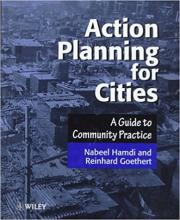| Title | Action Planning For Cities: A Guide for Community Practice |
| Publication Type | Book |
| Year of Publication | 1997 |
| Authors | Hamdi N, Goethert R |
| Publisher | John Wiley & Sons |
| ISBN Number | 0471969281 |
| ISBN | 978-0471969280 |
| Abstract | Planning suffers a crisis in confidence reflected in the growing consensus about its inability to manage fast changing cities effectively, and about its means and ends. Few of its benefits reach the urban poor majority. Action Planning for Cities brings together state of the art methods and techniques. It proposes practical and common sense alternatives, linking the needs of community with the strategic plans of government. Its methods are problem driven, community derived, participatory, fast, adaptive and incremental. In practice, its impacts are immediate and more easily sustainable. Action Planning can be used to improve city management by stimulating partnerships amongst stakeholders and by capacity building at all levels. It can be applied to a variety of settings, including infrastructure planning, environmental management, urban upgrading, settlement planning, community development. This book is organised into four sections. The first introduces an alternative theoretical agenda for planning based on a critical review of current development theories and practices. It traces the origins of Action Planning and describes its characteristics, methods and techniques. The second section reviews and analyses examples of participatory planning currently in operation and explains the disparate methods and techniques in use. Section three studies the links between action planning and learning. It sets out a basis on which to plan training programmes and decide appropriate educational settings and training conditions. The book concludes with a series of case files that clearly illustrate the principles and practice of action planning programmes. Action Planning for Cities is designed to be used as both a practical guide and for field and academic training. It contains easily reproduced charts and formats with illustrations of good practice. It will be of great value to development practitioners, educators and students. Of great importance in development planning in developing countries, the approach is also relevant in Eastern Europe, USA and the EU. "This book has much to recommend it. Any reader who is already at the coal face of action planning will find it a useful reference work. Any reader who works in an ivory tower for international funding agencies will find it an invaluable introduction to the alternative approach. The case studies make very interesting reading and the book is peppered throughout with photographic illustrations of community workshops in session, exhibition materials, visual aids, etc." -Tim Catchpole, URBAN DESIGN, October 1998 |
